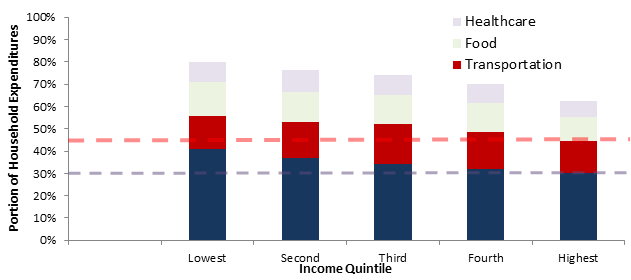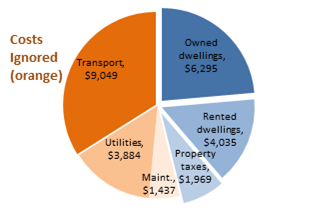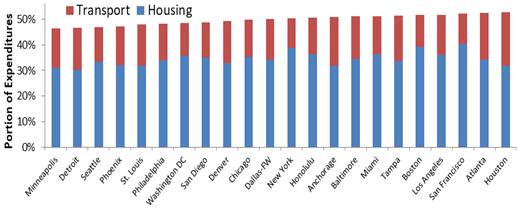The International Housing Affordability Survey rates affordability in selected urban regions. Although presented as objective research, the IHAS is actually propaganda. Users of this information should be warned about its biases
Housing and transportation are most household’s two largest expenditures, representing more than half of an average family’s spending, and an even larger share for lower-income households. This is far more than considered affordable. When families cannot afford food or healthcare, the real reason is generally excessive housing and transport costs that leave insufficient money to purchase other goods.

Affordability was previously defined as households spending less than 30% of their budget on housing, but is now is defined as households spending less than 45% of their budget on housing and transport (H+T) combined. Most low- and moderate-income households spend more than is considered affordable
The International Housing Affordability Survey (IHAS), by Wendell Cox and Hugh Pavletich, rates housing affordability for selected urban regions. It is heavily promoted by its authors and receives considerable media attention. A new study, "True Affordability: Critiquing the International Housing Affordability Survey, by Todd Litman, critically evaluates the IHAS. It identifies significant problems with IHAS analysis methods, and finds that many of its conclusions and recommendations are unsupported by research.
The IHAS only considers a limited set of housing types, geographic areas and impacts. It uses Median Multiples ratings, which measure the ratio of housing prices to incomes, but ignores other household costs including utilities, maintenance and transportation. The costs it ignores tend to be larger on average than the costs it considers. These omissions exaggerate the affordability of urban-fringe housing, and the significant savings provided by compact infill development.

The Median Multiple reflects house purchase costs, which affect owned and rental housing and property tax costs (blue slices). However, it does not account for house maintenance, utility and transport costs (orange slices), which are on average larger than the costs considered. This exaggerates the affordability of detached, urban-fringe housing. These omissions help explain the large differences between IHAS affordability rankings and those that directly measure housing and transport expenditures.
According to study author Todd Litman, “The IHAS ignores basic household economics. A cheap house is not truly affordable if located in an isolated area where transportation is expensive, and households can rationally pay more for a house in a walkable urban neighborhood with low transportation costs.”
The study found large discrepancies between the IHAS and other affordability rating systems. For example, the IHAS ranks Atlanta and Houston more affordable than Seattle and Washington DC, but when evaluated by actual housing and transportation expenditures, the rankings reverse, because the sprawled regions’ low housing costs are more than offset by their higher utility and transport costs.

Although Houston and Atlanta households spend relatively little on housing, this is offset by their high transport costs, making them least affordable of all regions included in the U.S. Consumer Expenditure Survey.
The IHAS ignores other factors that affect houses prices; the regions it rates most affordable are smaller, lower income, geographically unconstrained and declining in population, while those rated unaffordable are all large, attractive, high income, geographically constrained, and growing in population and economic activity.
The IHAS makes numerous conclusions and recommendations unsupported by research. It blames housing unaffordability on urban containment regulations, although they are actually uncommon and less costly than regulations limiting affordable infill.

The IHAS blames urban containment policies for high housing prices, although the research it cites actually indicates that urban infill restrictions are much more common and costly, and therefore contribute much more to housing unaffordability.
It ignores many costs of sprawl and benefits of Smart Growth. It ignores the mobility needs of people who cannot, should not or prefer not to drive, and growing demand for walkable communities. Recent consumer surveys indicate that most households want to locate in a walkable urban neighborhood, and would choose a townhouse or apartment in an urban neighborhood that offers a shorter commute and easy walking to shops, over detached housing in an automobile dependent area.
The IHAS fails to reflect professional standards: its analysis is not based on current best practices, is not transparent, misrepresents key research, fails to respond to legitimate criticism, and lacks peer review.
At best, the Median Multiple can help identify regions with high housing prices, but this only reflects a minor portion of total household costs and so is insufficient for diagnosing unaffordability problems or evaluating solutions. A high rating does not necessarily mean that most households experience excessive cost burdens, nor does a low rating indicate that an area is overall affordable. More comprehensive indicators give very different conclusions concerning affordability problems and solutions; the devil is in the analysis details.
This critique indicates that the IHAS is propaganda, intended to advocate an ideological position rather than provide objective analysis. The authors have a political agenda: they support urban expansion and oppose policies that result in more compact and multimodal development. Anybody who uses IHAS data should be warned about these omissions and biases.
A Dozen Missing Caveats
Any good study includes detailed discussion of possible omissions and biases. The IHAS fails to do this. Here are a dozen caveats that users should consider when using its information.
- The Median Multiple is a poor indicator of overall affordability. Experts recommend evaluating affordability based on total housing and transport expenditures. The IHAS uses outdated citations to justify Median Multiple.
- It only includes a limited set of urban regions, and ignores some of the most affordable. It oversamples smaller U.S. and Canadian regions, which exaggerates North American affordability.
- It excludes or under-samples some affordable housing types, including secondary suites, condominiums, rentals and subsidized housing. This exaggerates unaffordability in areas where such housing is common.
- It ignores house operation and transportation costs, which exaggerates the affordability of detached, urban fringe housing. Considering these costs, the sprawled regions it ranks as affordable, such as Houston and Atlanta, are actually least affordable because their low housing costs are more than offset by expensive transport.
- It only measures entire urban regions, ignoring evidence that more central neighborhoods are generally more affordable, considering total housing and transport costs, and offer other benefits to residents.
- It ignores many factors that contribute to high housing prices. Virtually all high Median Multiple regions are attractive, growing, economically successful and geographically constrained, factors the IHAS overlooks.
- It claims inaccurately that urban containment policies are the main cause of housing unaffordability, although even its citations indicate that regulations limiting infill are far more common and costly. It makes unrealistic claims concerning the amount of affordable development possible in geographically-constrained regions.
- It ignores the transportation needs of people who cannot, should not or prefer not to drive, and the isolation and additional costs they experience living in an automobile-dependent area.
- It overlooks the large and growing demand for housing in walkable urban neighborhoods.
- It ignores many costs of sprawl and Smart Growth benefits. It inaccurately describes Smart Growth and overlooks many ways that compact development can increase affordability and respond to consumer demands.
- It claims inaccurately that sprawl helps achieve economic development and social equity goals, when good research indicates the opposite: more compact and multimodal development tends to increase, economic productivity and opportunity. It claims incorrectly that Hsieh and Moretti’s research supports urban expansion when these researchers actually recommend more affordable infill and public transit improvements.
- The IHAS lacks transparency, discussion of possible analysis biases, and peer review.
FULL STORY: True Affordability. Critiquing the International Housing Affordability Survey

Planetizen Federal Action Tracker
A weekly monitor of how Trump’s orders and actions are impacting planners and planning in America.

Chicago’s Ghost Rails
Just beneath the surface of the modern city lie the remnants of its expansive early 20th-century streetcar system.

Amtrak Cutting Jobs, Funding to High-Speed Rail
The agency plans to cut 10 percent of its workforce and has confirmed it will not fund new high-speed rail projects.

Ohio Forces Data Centers to Prepay for Power
Utilities are calling on states to hold data center operators responsible for new energy demands to prevent leaving consumers on the hook for their bills.

MARTA CEO Steps Down Amid Citizenship Concerns
MARTA’s board announced Thursday that its chief, who is from Canada, is resigning due to questions about his immigration status.

Silicon Valley ‘Bike Superhighway’ Awarded $14M State Grant
A Caltrans grant brings the 10-mile Central Bikeway project connecting Santa Clara and East San Jose closer to fruition.
Urban Design for Planners 1: Software Tools
This six-course series explores essential urban design concepts using open source software and equips planners with the tools they need to participate fully in the urban design process.
Planning for Universal Design
Learn the tools for implementing Universal Design in planning regulations.
Caltrans
City of Fort Worth
Mpact (founded as Rail~Volution)
City of Camden Redevelopment Agency
City of Astoria
City of Portland
City of Laramie




























